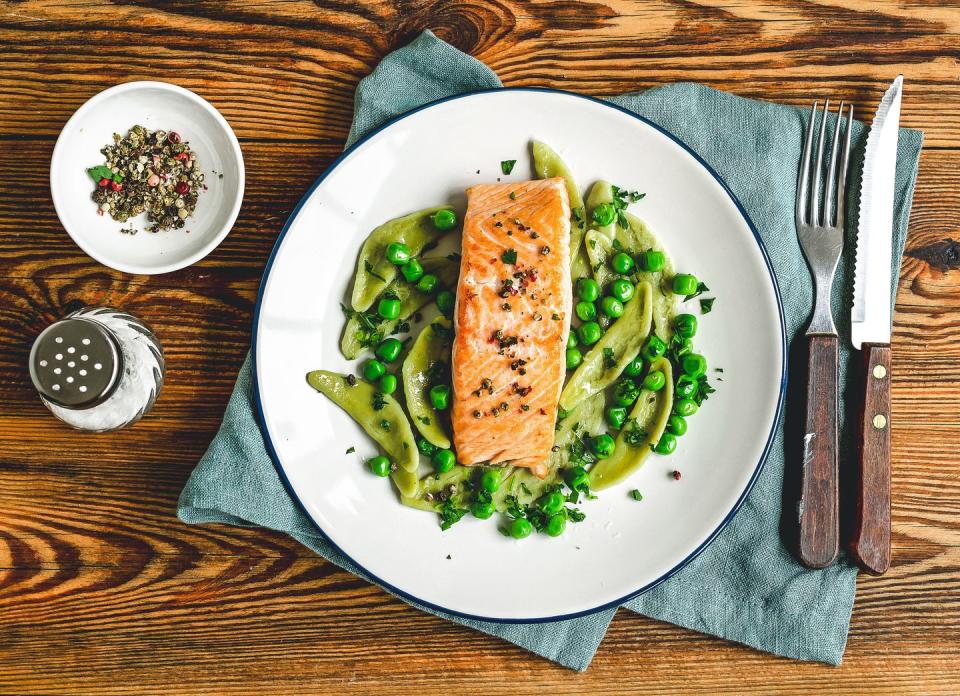The immune system benefits of Vitamin D, and how much you should be getting

There’s been a buzz around vitamin D for a while, but now it looks like it might play an even more important role in our health and wellbeing than has been previously realised.
The warmth of the sun on our skin definitely helps to raise our spirits, but it also has important implications for our ability to fend off illness. As our hopes of a return to normality focus on the vaccine rollout programme, there has been increasing debate among scientists and medics about the role of vitamin D and its potential protective effect against respiratory illnesses, including Covid-19, and how much vitamin D we should take.
It is through the sun’s UV rays acting on our skin that we obtain 90% of our vitamin D, so supplements may seem less important as warmer weather approaches. However, many people don’t tend to expose their skin to the sun much, even in summer, for a variety of reasons and, while our summers are often fleeting affairs, sadly, coronavirus is not.
The groups that are at increased risk of becoming very ill with Covid-19 are also those more commonly deficient in vitamin D, such as older people, people who are overweight, and Black and Asian people, explains Adrian Martineau, an expert on vitamin D, and clinical professor of respiratory infection and immunity at Queen Mary University of London.

There is a lack of clinical evidence around vitamin D and its role in fighting coronavirus, hence the continuing debate, but Professor Martineau is now leading the CORONAVIT trial, the UK’s national clinical research, to see if taking vitamin D can reduce the risk or severity of Covid-19. The trial, which is charity-funded, is due to finish at the end of June this year.
Meanwhile, the current advice is for at-risk groups and those in care homes to take 400iu(international units) or 10ug(micrograms) of vitamin D3 all year round, with everyone else taking the same amount in autumn and winter. D3 is derived from animal sources and thought to be most effective but D2, from plant sources, also raises vitamin levels.
Professor Martineau, who personally takes 400iu of vitamin D, welcomed the ‘positive tone’ of this guidance issued by the National Institute for Clinical Excellence (NICE),in collaboration with two other health bodies, at the end of last year. Other people, in contrast, are more critical.

A significant group of specialists think the recommended amount should be 800 to 1,000iu, and they want us all to understand why – that vitamin D is important for our immune health and not just for bone and muscle. ‘Evidence linking vitamin D deficiency with Covid-19 severity is circumstantial but considerable,’ they wrote in a paper for The Royal Society of Medicine last year.
HOW CAN I TEST MY VITAMIN D LEVELS?
The most accurate way to check vitamin D levels is the 25-hydroxy vitamin D blood test, but GP Dr Sarah Jarvis says most doctors only offer this if you’re at very high risk of severely low levels and otherwise recommend supplementing anyway. Meanwhile, specialists point out there’s no agreement on the optimum vitamin level, but the risk of weak bones and muscles rises when levels drop below 25nmol/L (nanomole per litre) according to NICE. Critics say this is the lowest threshold level of any country.
Dr Richard Quinton, one of the authors of the Royal Society paper and a senior lecturer in endocrinology at Newcastle University, shares the belief that the low threshold was based on flawed research. In the first wave of the pandemic, Dr Quinton discovered vitamin D levels in Covid-19 patients were extremely low, and particularly so among patients requiring intensive care. ‘We prescribed high doses [of vitamin D] with a view to rapidly achieving normal levels and this was well tolerated,’ says Dr Quinton.
He feels every doctor or scientist taking part in the public debate about vitamin D should be open about how much of the vitamin they take themselves. ‘It’s rumoured that many members of the Scientific Advisory Committee on Nutrition (SACN), which endorses the 400iu/10ug recommendation, are personally taking rather more than this amount,’ he says.‘Personally speaking, from October to April, I take 4,000iu of vitamin D three times a week, as do my wife and three teenage children. Taking higher amounts is safe and could very well save lives. During summer, I’m a big fan of sunbathing without burning, and I only apply sunscreen to my head, neck, arms and shoulders.’

HOW DOES VITAMIN D WORK IN THE BODY?
The consensus is now that vitamin D is not really a vitamin at all, but a hormone. ‘When it was first discovered that cod liver oil could cure rickets, it was considered that foodstuffs were the source of vitamin D and it was viewed as a nutritional supplement,’ explains Martin Hewison, professor of molecular endocrinology at the University of Birmingham. ‘Calling it a vitamin is confusing, but it has never been renamed.’
Vitamin D is synthesised in our skin in response to UV rays, but to become functionally active it has to be metabolised in the kidneys, which is why it is classified as a hormone says Professor Hewison. ‘Nearly every cell in our bodies expresses vitamin D receptors, including the cells of our immune system,’ he adds.
In the first instance, vitamin D prompts a strong antibacterial response from the innate immune system (our first line of defence), to kill pathogens.If this fails, our adaptive immune system (the second line of defence), attacks by creating inflammation. This can get out of control, however, if immune cells overreact and start to attack the body’s own organs, causing sepsis. It is then that vitamin D has a dampening effect.
‘Vitamin D acts very much like steroids that dampen down the inflammatory response,’ says Professor Hewison, another author of The Royal Society paper, who would like to see 800iu vitamin D recommended and takes 2,000iu a day himself.

AM I VITAMIN D DEFFICIENT?
It’s possible the answer is yes, since two out of five UK adults have insufficient vitamin D in winter and spring. Not surprising, perhaps, as two out of three of us don’t take any vitamin D supplements at all, according to research led by Professor Martineau.
By March, our vitamin D levels are at their lowest. How quickly they are restored depends on the weather through April and May, but also on our skin tone, the amount of skin exposed to the sun and at what time of day, our geographical location within the UK and the amount of cloud cover on any given day, according to Professor Martineau.

Sunscreen is vital to protect us from skin cancer, but it also blocks synthesis of vitamin D. The best advice is to try to spend a short time each day outside between midday and 3pm with at least your forearms exposed, but obviously not for long enough to allow burning.
Those with dark skin have more melanin, which reduces the skin’s ability to make vitamin D, and everyone of Black, Asian and minority ethnicity living in the UK should assume they are deficient in vitamin D throughout the year, and more severely so in winter, advises Dr Quinton.
Anyone who is overweight or obese is also more likely to be deficient in vitamin D. This may be because vitamin D is stored in fatty tissue, so less circulates in the blood but, as yet, there is no specific advice about whether they should take a higher level of supplement.
Low vitamin D levels are associated with many other conditions, including heart disease, dementia and some kinds of cancer, but much more research is needed. ‘Most of these associations with low vitamin D haven’t gone on to be proven in clinical trials, so low vitamin D may well not be causal,’ explains Professor Martineau. ‘The vitamin D level could be a “bystander”, meaning it’s a chance association or a consequence of disease.’
HOW MUCH VITAMIN D SUPPLEMENTS IS IT SAFE TO TAKE?
When vitamin D is obtained naturally from sunshine, our bodies cleverly regulate the amount absorbed. In terms of supplements, it is safe to take up to 4,000iu or 100mcg of vitamin D a day, according to NICE guidance.
Taking very large amounts of vitamin D,in excess of 10,000iu, over a long period could cause excess calcium to build up in the body, a condition called hypercalcaemia, which can ultimately weaken bones and damage the heart and kidneys. If you have concerns about a pre-existing condition, ask your GP or consultant’s advice.
Clearly, much is still to be discovered about the role of vitamin D in our health. We don’t yet know if taking it will help with recovery from long-term effects of Covid-19. But Professor Martin Hewison sums up current thinking: ‘Vitamin D is not a magic bullet that protects you against infections, including Covid-19, but it does pep up your immune system and at least loads the dice in your favour.’
WHAT ABOUT VITAMIN D IN OUR DIET?
We derive a small amount of vitamin D from our diet. Oily fish, such as salmon and mackerel, red meat, liver, egg yolks and mushrooms are the best sources, says Tracy Parker, senior dietitian with the British Heart Foundation (bhf.org.uk). Vitamin D is also added to cereals, butter alternatives, orange juice and some plant-based milk alternatives.
Sign up to our newsletter to get more articles like this delivered straight to your inbox.
In need of some positivity? Get delicious recipe ideas, uplifting lifestyle news, and fashion and beauty tips. Make the most of your time at home and enjoy Good Housekeeping delivered directly to your door every month!
You Might Also Like

 Yahoo Finance
Yahoo Finance 